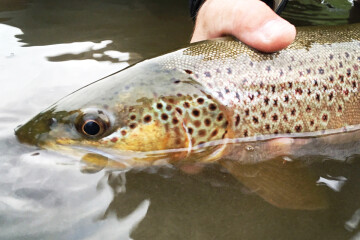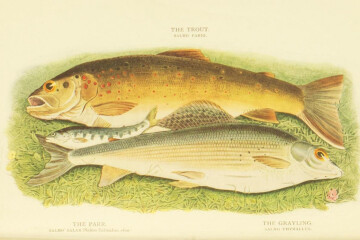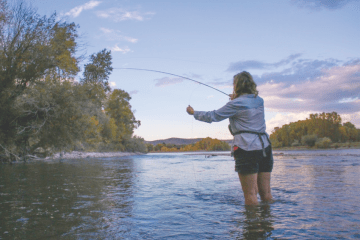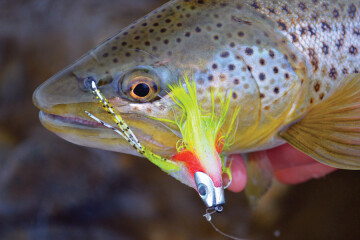Winter Fly Fish Wish
Fishing is a year around sport. Each season presents different challenges and techniques, but the opportunity to enjoy the sport is always available. No matter how cold it is, fish have to eat. They may move less and feed on more marginal food sources, but fly fishing can still be fun.
Fly fishing is the most Zen-like way to fish. Much of it is catch and release. So why brave the cold for a few fish? Fishing is therapy. When the rod and line are in sync, so are our lives. Some call it “ripping lips,” “going on a slay ride,” or “drowning worms.” No matter what you call it, fishing is an excuse to get outdoors and take your mind off of life’s challenges.
Winter fishing requires some modifications and special tips
Comfort comes first! Winter fishing can be really cold. If you are not comfortable, you are not fishing. Fingers and toes are usually the first thing to consider. If you can’t tie a knot, you will be spending your time standing in a cold river with your hands in your pockets. Keep your body core warm. Layers of thin, modern fabrics can be added or removed as needed. Since these fabrics are thin, they are less bulky. Hand warmers are a necessity. Use a gel or waterproof style of pocket furnace. The cloth powder packs will get wet and worthless in short order. Most of your heat will escape from your neck and head. Wear a scarf, bandanna, and a decent hat. The hat should be dull in color, to keep you stealthy, and have a visor to reduce glare. Polarized glasses are also essential to protect your eyes from glare and help you to see the fish.
Slow things Down! Cold water causes many food sources to become dormant. Trout, and other species, need to move less so they can save stored energy. You will not find the fish in the fast moving currents or experience aggressive strikes. The fish will be holding in areas where food and cover exist. Donnell from Fishermen's Pond always recommends bringing along a trusty fish finder and GPS combo (like one of these) to help you locate your next catch even in tougher conditions like winter fishing.
Cast less but cast smarter! Trout tend to hold in deep water, in an eddy, or slow moving current. The seam between the still and moving water is their feeding site. Look for the fish before casting. Using additional weight is often required. A drag free drift is essential as always. Casts need to be right on the money. The fly must be seen by the fish at least a yard upstream so they can start preparing to see and eat it. Since the fish’s eyes are on the side of their heads, they can’t see what is directly in front of their face. They need to swerve to the side for a clear view. Also, by casting less, your hands can stay warmer longer tucked into your heated pockets.
Placement, presentation, and appearance! Why will a fish pick your fly out of a herd of natural offerings? If your fly is easy to eat, familiar, and looks tasty, they will eat it. They will not move far in the cold water. Every motion requires energy. The fly needs to be on target.
The fly must also stand out from the other natural foods and say “Eat Me!” Most fish are color blind, so reflective, trashy materials help attract attention. At seminars, I talk about “wedding cake.” A wonderful cake is cut into dozens of pieces. It is all the same cake but we still pick a certain, special piece. Maybe it has extra icing, or is a corner, or has an extra decoration on it, but for some reason, we pick something different.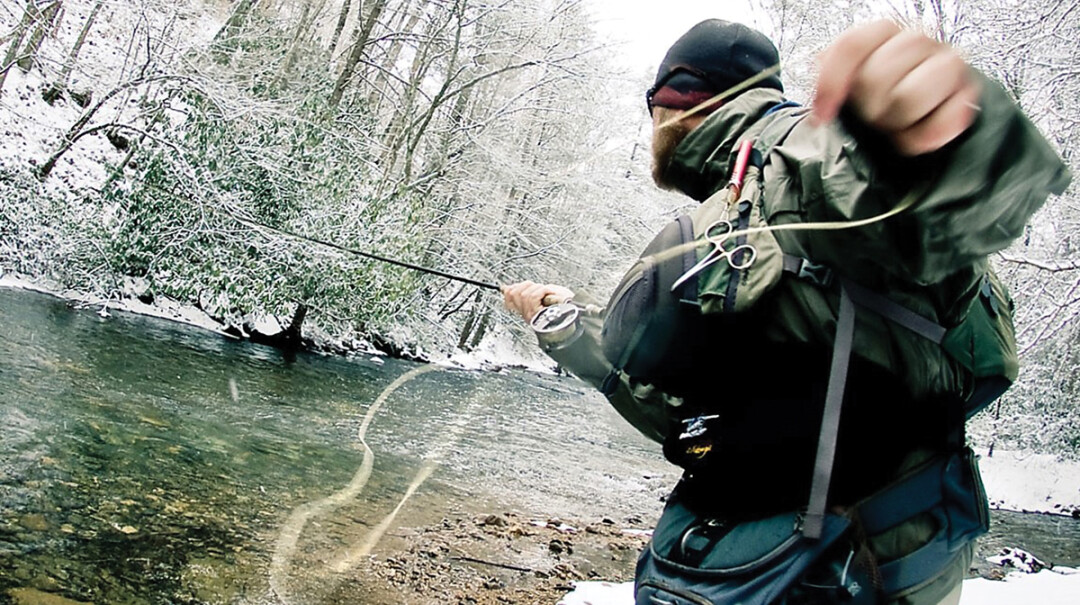
Fish have just moments to choose a meal. A little extra something will help them to choose your fly
Take a Break! Fishing must be FUN!!!! If it isn’t, then you are doing it wrong. Freezing cold can make the day miserable. Hot soup or beverages can save the day. Candy bars and energy snacks can refuel your body’s furnace, so you can get back to fishing. It is funny how when the fishing is hot, you never think about being cold. When fishing cools off, so do your toes and fingers. Find a warm and sunny rock to take a break. Continue to look for rising or feeding fish. Once you are warm and ready, take another cast.
90% of a fish’s diet is subsurface! Nymphs are what is for dinner in the cold water of winter. Attractors such as glow eggs and San Juan worms also work well. Streamers are less likely to work when fished as a fast- moving minnow. A slow, natural drift is required. Seeing a strike may require a strike indicator. Set the hook on any movement or change in the drift. If you can see the fish, look for any movement that indicates they mouthed your fly.
There are times when dry flies can be effective. On sunny days, or where warm water discharges occur, hatches can be prevalent. These Midge hatches are a winter staple for the fish familiar with them. Size 18-22 flies are usually needed attached to fine tippets. Also, try a larger attractor dry fly with a shallow midge nymph dropper.
Sharpen your hooks and set the hook sharply. Sharp hooks catch 3-4 more fish than you are currently using. Even new hooks can use a little sharpening. The point of a hook must penetrate a mouth made of cartilage. This material is like your fingernails, hard and without nerve endings. Studies show that barbed hooks are not the main culprit for fish mortality. Handling the fish roughly or dragging them onto the bank will kill way more fish than barbs. Fish friendly nets are also important. A plastic net fabric will not wipe the fish’s protective mucus coating from their skin. The longer you fight and handle a fish, the higher the mortality will be. Netting a fish will allow you to handle the fish quickly, and safely while still in the water. Forceps are wonderful for hook removal. Once you are done with the fish, warm your hands and get ready for the next catch.
Fish When You Can! If you wait for a perfect day to fish, you will spend fewer days on the water. Adapt and adjust to the conditions you are offered. Consider fishing midday, or in a location in the sun, less windy, or more comfortable. Every cast is an opportunity for success. No matter how many times we fish, “one more cast” is always needed. That is because of Hope! If you don’t cast, then there is no hope to catch another fish. The metaphor also applies to our lives.
Fishing is just fishing! It is not called “catching.” “Fishing” is about challenging ourselves, searching, seeking, and discovering. Fewer crowds of fishermen tend to brave the winter waters. Not everyone is willing to escape a Fat Boy Lazy Chair for a cold winter trout stream or lake. Great fishermen do not fish because it is easy. They fish because it is hard. For those that are hearty and brave enough to venture outdoors, the experience can be wonderful, educational, and rewarding!
Stay warm, active, and fish in the winter too!

